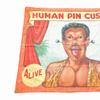Donald Ellis Gallery exhibiting at Winter Antiques Show
- NEW YORK, New York
- /
- December 08, 2010
Arguably the most important Native American object to be offered for sale since the 1940s will be unveiled by the Donald Ellis Gallery at the Winter Antiques Show which takes place at Park Avenue Armory, 67th Street and Park Avenue, New York, from Friday 21 to Sunday 30 January 2011 (Booth 4). Donald Ellis, a leading dealer in this field, has exhibited at this prestigious fair for fifteen years and was the first Canadian to be invited to participate.
While the Gallery’s stand will present a wide range of objects from the Northwest Coast, Alaska and the Eastern Woodland regions of North America dating from 200 BC to the early 20th century, the talking point for visitors to the Show will undoubtedly be the extraordinary Eskimo masks from the estate of the Surrealist artist Enrico Donati (1909-2008). Yup’ik Eskimo masks are possibly the highest form of expression of Native American art and profoundly influenced the Surrealist artists who had escaped Paris in the Second World War and settled in New York. André Breton, Max Ernst, Roberto Matta, Wolfgang Paalan and Donati, among others, all owned significant examples and were the first to recognise them as exceptionally refined works of art.
The two Donati masks being offered by Donald Ellis are both of the highest museum quality and would be the ultimate prize for any specialist collector, as well as appealing to collectors of modern and contemporary art. The Donati Studio Mask has never been published or publicly exhibited until now, and was originally acquired by Adam Hollis Twitchell who began trading along the Kuskokwim River in Alaska in 1905. Twitchell, who purchased many of his masks directly from the natives immediately after the ceremonial dances that he had witnessed, collected what is now considered to be an iconic group of twelve ‘weather’ related Yup’ik masks. The last to come on the market was previously exhibited at the seminal Primitivism in 20th Century Art exhibition in 1984 at MOMA before being acquired by the legendary collector Ernst Beyeler for his Foundation in Basel where it is now on view. The Donati Studio Mask is the last of this group in private hands and has a price in excess of $2 million.
Its provenance is remarkable having been sold by Twitchell to George Gustav Heye whose collection moved to the Museum of the American Indian, Heye Foundation, in New York in 1916. Several masks, including this one, were de-accessioned in 1944 to the New York dealer Julius Carlebach who sold them to a number of Surrealists including André Breton. The iconic Breton swan mask, by the same hand as the Donati Studio Mask, is now in the Pavillon des Sessions at the Louvre. The Italian-American Surrealist artist Enrico Donati acquired his mask in 1945 and it hung in the Gainsborough Studios on Central Park South for over sixty years, inspiring and influencing his art. The artist’s heirs chose to offer this and another mask, the Donati Fifth Avenue Mask, through the Donald Ellis Gallery rather than at auction.
The second Yup’ik mask, the Donati Fifth Avenue Mask, has the same provenance and is one of three such examples, the others being in the Detroit Institute of Arts and the Museum für Volkerkunde, Hamburg, Germany. Hamburg acquired this mask at the historic Surrealist Objects exhibition curated by Breton in Paris in 1936. This elaborate dance mask depicts a central concept of Yup’ik cosmology: the shaman’s journey to the spirit-world in search of good fortune for his people in the coming year. In this dramatic composition, the spirit of a shaman travels to the dream world with the help of his animal spirit helper, a seal.
Another Yup’ik mask from Nunivak Island, Alaska, circa 1900, was formerly in the Ralph Altman collection, Los Angeles. This extraordinary mask appears to be the earlier, original version of a later mask collected by the anthropologist Margaret Lantis in 1946 which was also included in the Primitivism in 20th Century Art exhibition in 1984 at MOMA.
A war club carved from caribou antler, circa 1780-1810, would have been the prized possession of a Tsimshian chief (fig. 4). An exceptionally rare object, this club is the finest of the 15 surviving examples. Unusually, it has a small subsidiary figure of a baby bird just above the grip area. The exquisitely executed design of bird images flowing gracefully over the surface and the refined composition of the carving indicate an artist with true mastery of the Northwest Coast tradition. A globular rattle may also come from the Tsimshian or, more probably, the Haida people. Such rattles belonged to shamans on the Northwest Coast who placated the spirits that were employed in curing rituals. The designs on each side of this carved and painted hardwood rattle represent ethereal and spirit-like faces and are typical of the early 19th century. Few such globular rattles exist outside the older museum collections and even fewer have come on to the market for several decades.
Other treasures that will enthral visitors to Booth 4 include a remarkable Haida wooden bowl in the form of a seal from Queen Charlotte Islands, British Columbia, dating from the late 18th or early 19th century, and from the Tlingit tradition an unusual bird mask with articulated eyelids dating from circa 1830-1850, and a small crouching naked figure dating from circa 1860. The oldest piece is an Okvik Eskimo Janus Headed Ulu or ‘woman’s knife’ dating from 300 BC-100 AD made from walrus ivory and slate. From outside Canada, a 19th century stylised stone buffalo effigy with turquoise-inset eyes from Pueblo, New Mexico, would look completely at home in any contemporary collection. Prices range from $1,500 to over $2 million.













31100x100_c.jpg)

